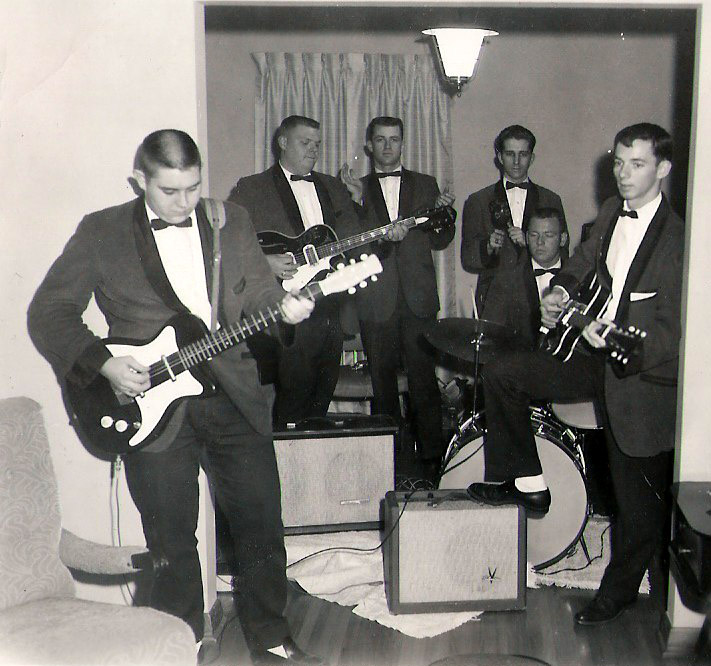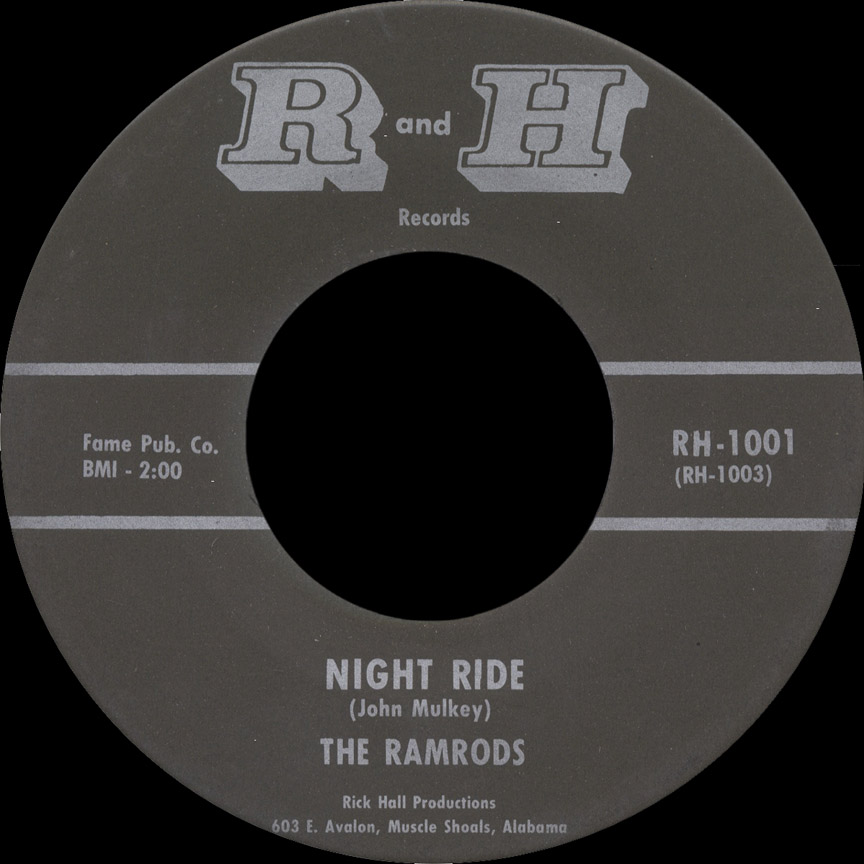
 Jon Adair of the Ramrods and Mike from the Alabama Record Collectors Association wrote this history of the band, reprinted with permission. If anyone has a good scan of the Queen 45 or transfers of missing songs, please contact us.
Jon Adair of the Ramrods and Mike from the Alabama Record Collectors Association wrote this history of the band, reprinted with permission. If anyone has a good scan of the Queen 45 or transfers of missing songs, please contact us.
The year was 1959. Five guys from Woodlawn High School in Birmingham, Joe Lackey (lead guitar and vocals) Butch Fadely (piano), Jim McCulla (drums) and Larry Wooten (rhythm guitar) had gotten together and decided to form a band of their own. Jon Adair, who was a friend of Joe’s, had already been in two bands, ‘The Teen Beats’ and the ‘The Ray Royster Combo.’ None of the other guys had ever played in bands. Of course, all of them were in their mid-teens, 13 to 15 years old.
Joe asked Jon to come and sit in with them at a practice, which he did, playing rhythm guitar. Later, Joe and the other guys went to Jon’s house and asked him to join the band. When Jon joined, the rhythm guitar player, Wooten, was sick and couldn’t make the first gig, so Jon played rhythm alone. When Wooten returned, both he and Jon played rhythm, which the band really didn’t need two of, but the band had no bass player, which it did need, so they asked Jon to play the bass. He knew nothing about the bass and told them he definitely could not afford to buy another guitar, but wanting to be in the band, Jon compromised. He removed the two high strings from his 6-string electric and tuned the remaining four strings down one octave. It worked well enough to get by. In fact, this is what was used later on their first record, “Fire Tower.” This is how they played until Wooten left the band and Jon moved permanently to rhythm. It was also about this time that Butch Fadely left the band to join the Army.
 The band took the name, the Ramrods, from the Duane Eddy tune and even adopted that song as their opening number on every show.
The band took the name, the Ramrods, from the Duane Eddy tune and even adopted that song as their opening number on every show.
There were not many local bands around at this time. The Roulettes, the Premiers, The Epics and now the Ramrods were just a very few. That, of course, would soon change, especially after the Beatles hit America in 1964. Bands began to pop up everywhere, but, for now, the Ramrods and these other few had a corner on the market.
Many member changes would soon take place in the Ramrods, including adding Paul Newman on vocals. The Ramrods also decided to add a saxophone player, so Ronnie Eades joined the band. Ronnie would later move to Muscle Shoals and become a prominent member of the Muscle Shoals Sound as a session musician.
In 1961, a friend of a friend of a friend, met the Ramrods and wanted to record them. He, Wayne Bright, owned a recording studio in Muscle Shoals, “Bright Records.” The band agreed and laid down two tracks, “Fire Tower,” written by Paul Newman and “Sittin’ Alone,” written by Jon Adair. When the record was pressed, it had mistakenly listed the band as ‘Paul Newman and the Ramrod Combo’ instead of ‘The Ramrods.’
 They soon followed with their second record, “Slee-zee,” b/w “Slouch-ee,” both written by Joe Lackey. These were recorded at Homer Milan’s studio at 1st Avenue and 20th Street in Birmingham in 1962. It was released on Queen Records, which was a subsidiary of King Records.
They soon followed with their second record, “Slee-zee,” b/w “Slouch-ee,” both written by Joe Lackey. These were recorded at Homer Milan’s studio at 1st Avenue and 20th Street in Birmingham in 1962. It was released on Queen Records, which was a subsidiary of King Records.
Member changes continued with the addition of Fred Guarino on drums, Johnny Mulkey on lead guitar, Frank Bethea on bass, Bubba Lathem on piano, Durwood Bright on sax and Dwight Anderson on sax. Bright would later play with the Townsmen and Anderson with the Tikis.
In 1963, the Ramrods went into Baldwin Recording Studio in Woodlawn, which they did quite often after shows to record various tunes. On this trip, they recorded two original songs, written by John Mulkey, “Night Ride” and “Moonlight Surf,” both surf sounding instrumentals. They took the tracks to Rick Hall, who ran Fame Recording Studio in Muscle Shoals. He liked them and agreed to press the songs. The band had thought that their songs would be on the Fame label, which, although still a local label, was fairly well known. However, Rick was starting a new label, R and H, and released the Ramrods on it. Theirs was the first record on this label, the label number being RH-1001. This was an obvious disappointment to the band not to have been on Fame, but Hall had done a good job of mixing and producing the record and the band was happy with the result.
“Night Ride” started as a ‘Pick Hit’ on WSGN in Birmingham in 1963, but soon made it to WSGN’s Top 40 where it remained for thirteen weeks, reaching as high as #5.
During the band’s tenure, they toured all over the southeast, playing the college circuit and other venues and either opened for or backed up major national artists. A short list includes Del Shannon, the Four Seasons, Arthur Alexander, Tommy Roe, Chris Montez, Roy Orbison and Charlie Rich, but there were many, many more.
Also during this time, they had played shows with another Alabama band, the Webs, from Dothan. One member of the Webs was a guy named Bobby Goldsboro. By 1963, the Webs were traveling with Roy Orbison as his backing band, which had been arranged by another Dothan guy, Buddy Buie. Of course, Buddy was becoming a well-known songwriter and record producer. He had also become Orbison’s tour manager as a bonus for getting the Webs with Roy.
Jon Adair remembers fondly one concert both groups played together at the Cloud Room (Cascade Plunge) in Birmingham. After the show was over and the band was putting their instruments in the car, Bobby took out his acoustic guitar, sat on the hood of a car and told the guys that he was working on a song which he hoped to record as a solo.
He played “See the Funny Little Clown,” written by Bobby. A short time later, it became Bobby’s break-out solo hit and reached #9 on Billboard in early 1964. Bobby was now a solo artist with many hits to follow.
By the time 1964 rolled around, the Ramrods had been together for almost five years. Only Jon Adair and Joe Lackey remained as the nucleus of the original band from 1959. Jon had joined the Navy on a deferred enlistment program as a senor in high school and when he graduated in 1963 had to go straight to boot camp. However, when he completed it, he returned home where he rejoined the band. In April of 1964, the Navy called him to active duty. It was only a few months later that the Ramrods decided to disband.
What had actually happened was that the Webs, minus Bobby Goldsboro, were now touring with Roy Orbison as his backing band. Roy renamed them the Candymen, after his song title, “Candy Man.” The Candymen would later form the nucleus of the Classics IV and then the Atlanta Rhythm Section. In late 1964, Buddy Buie, who was Roy’s tour manager, was itching to form a new band, one to help showcase his songs. He took three members of the Ramrods (Guarino, Mulkey and Latham) and members of the Webs, including Wilbur Walton and Jimmy Dean and formed the James Gang. They made several records, mostly written by Buddy, but their biggest song was “Georgia Pines,” co-written by Buie. This song was also recorded by the Candymen. Their version peaked at #81 on Billboard, but the James Gang version received more regional airplay.
As for the remaining members of the Ramrods, after finishing his stint in the Navy, Jon went into the business world, as did Joe Lackey and Frank Bethea. Other members, as already mentioned, played in various local bands for a while.
Sadly, we have lost a few of these guys over the years, Joe Lackey, Harry Looney and Fred Guarino. Who knows, maybe one day there will be a reunion of the remaining members.
The Ramrods can really be considered one of the pioneer bands in the Birmingham area, one who inspired many other young musicians who also began to form bands and become prominent artists in their own right.
